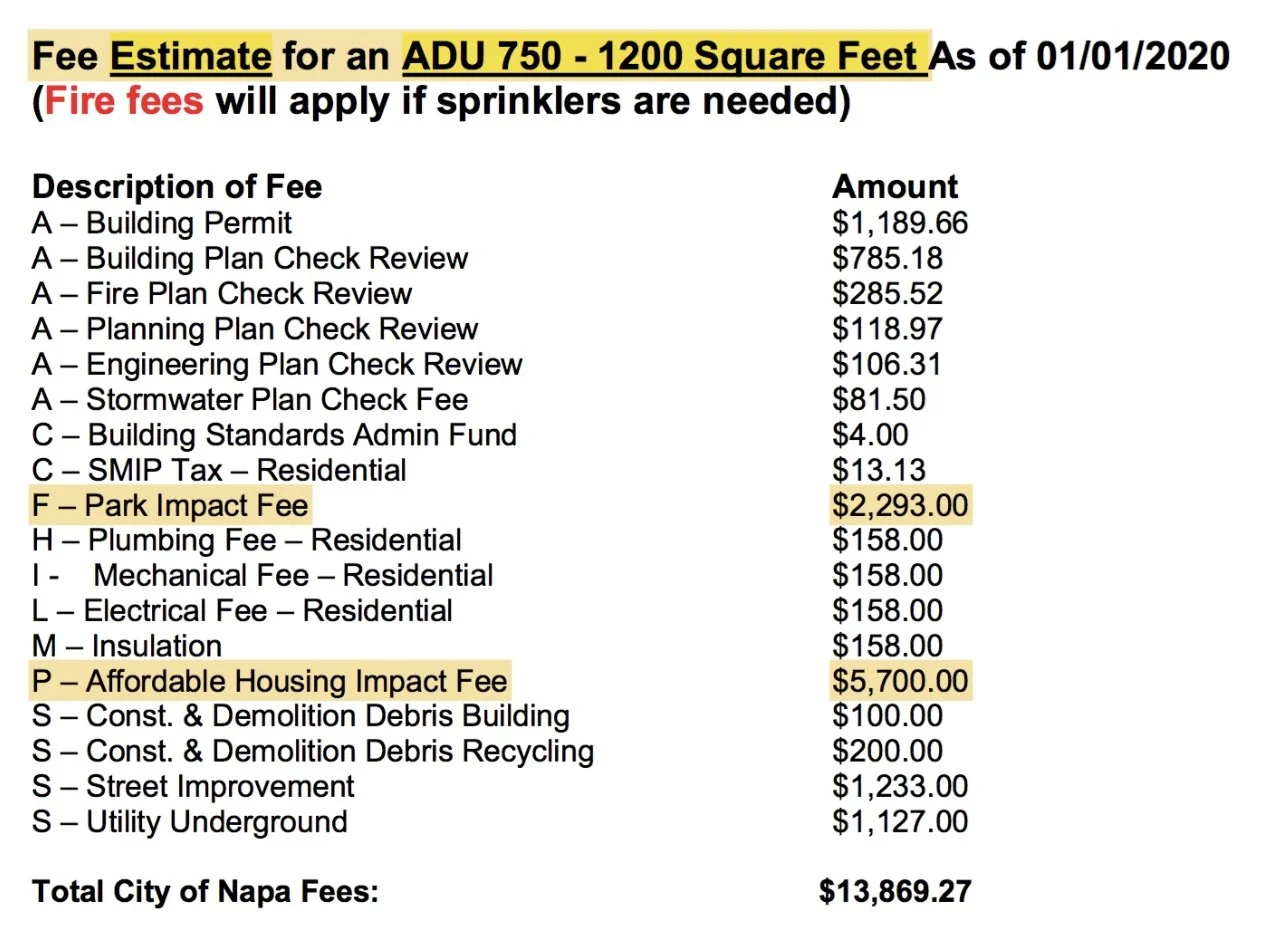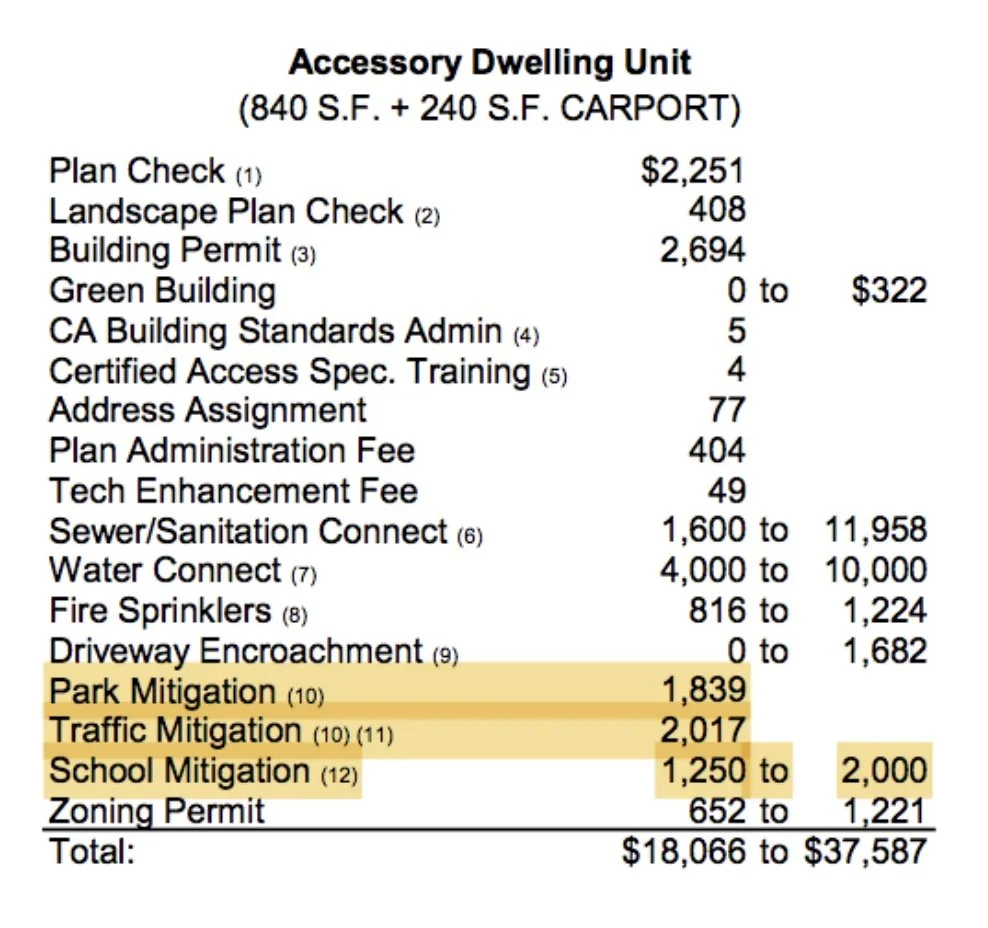What is impact fee?
ADU Impact Fees in California - a helpful guide to how they work with real examples
There isn’t one easy place to look up impact fees (either what they are, or how much they’ll be for your Accessory Dwelling Unit). And it’s one of the parts of the new ADU rules where I’ve seen the most confusing guidance from the state, so it’s natural that you’ve got questions.
This article tries to tackle the big subject of ADU Impact Fees in California.
We’ll show our research on what impact fees are, how to estimate the impact fees for your project, a few ways to avoid some impact fees, and more.
What are ADU Impact Fees?
Even the definition of impact fee is actually a bit murky, and you’ll get a really classic example of that when we talk about school fees later in this article.
Broadly, the phrase “impact fee” usually refers to a fee levied by a local agency (this can be the city, a school district, a department, or any number of institutions) in order to mitigate the effect of a development project.
Usually, the approval of a big residential development will be conditional on the developer paying an impact fee to help with public goods like schools and parks.
In AB 68 (one of the big pieces of legislation that streamlined the ADU rules across the state starting in 2020), “impact fees” are defined:
…For purposes of this paragraph, “impact fee” has the same meaning as the term “fee” is [sic] defined in subdivision (b) of Section 66000, except that it also includes fees specified in Section 66477. “Impact fee” does not include any connection fee or capacity charge charged by a local agency, special district, or water corporation.
—AB 68 approved by Governor October 09, 2019
This 2003 guidance from the League of California Cities explains:
“A development impact fee is a monetary exaction other than a tax or special assessment that is charged by a local governmental agency to an applicant in connection with approval of a development project for the purpose of defraying all or a portion of the cost of public facilities related to the development project. (Gov. Code § 66000(b).“
The California Department of Housing and Community Development (HCD) explains:
“Impact fees charged for the construction of ADUs must be determined in accordance with the Mitigation Fee Act and generally include any monetary exaction that is charged by a local agency in connection with the approval of an ADU, including impact fees, for the purpose of defraying all or a portion of the cost of public facilities relating to the ADU.”
I have no idea what that extra “including impact fees” is for!
In any case, if you’re building an ADU, you may be asked to pay some fees to offset the burden on public goods like schools and parks.
Here’s an example of a fee estimate from the city of Napa (where I live).
You can see I’ve highlighted two rows…
“Park impact fee” and “Affordable housing impact fee” are clearly labeled as impact fees.
You may find other fees in your city or county fee schedule which are described as impact or development fees.
If your city or county has fee estimates like this, it’s a good idea to highlight any substantial fees that may be considered impact fees.
Here’s another example from the county of Sonoma where the fees are referred to as “Mitigation” fees.
You get the idea - they can be called a lot of things.
But whenever you see a fee that sounds like you’re being asked to pay for your impact on the community, you should look into whether that’s an impact fee.
It matters a lot, because ADUs under 750 square feet don’t have to pay impact fees.
And ADUs that are 750 square feet and up may pay reduced impact fees, proportional to their size in relation to the primary dwelling.
ADUs under 750 square feet shouldn’t have impact fees
Impact fees are usually overseen by local agencies like city planning, county planning, special districts or water corporations.
But the state law now says that these bodies shouldn’t apply impact fees when homeowners are developing ADUs under 750 square feet.
The California state legislature passed laws (captured in Assembly Bill 68 / Assembly Bill 881 / State Bill 13) that amend the Government Code and Health and Safety Code to this effect.
It’s pretty black and white in the state law:
A local agency, special district, or water corporation shall not impose any impact fee upon the development of an accessory dwelling unit less than 750 square feet. Any impact fees charged for an accessory dwelling unit of 750 square feet or more shall be charged proportionately in relation to the square footage of the primary dwelling unit.
—AB 68 approved by Governor October 09, 2019
The notable exception of School District Impact Fees
Even when the law seems black and white, there’s always room for me to be surprised.
The HCD recently updated its guidance about school fees, saying that school districts are still allowed to charge fees when somebody develops an ADU above 500 square feet in size.
Can school districts charge impact fees?
Yes. School districts are authorized but do not have to levy impact fees for ADUs greater than 500 square feet pursuant to Section 17620 of the Education Code. ADUs less than 500 square feet are not subject to school impact fees. Local agencies are encouraged to coordinate with school districts to carefully weigh the importance of promoting ADUs, ensuring appropriate nexus studies and appropriate fees to facilitate construction or reconstruction of adequate school facilities.
Over 750 square feet, impact fees should be “proportional”
The HCD has clarified how local agencies should calculate proportional impact fees:
“Proportionately” is some amount that corresponds to a total amount, in this case, an impact fee for a single-family dwelling. For example, a 2,000 square foot primary dwelling with a proposed 1,000 square foot ADU could result in 50 percent of the impact fee that would be charged for a new primary dwelling on the same site. In all cases, the impact fee for the ADU must be less than the primary dwelling. Otherwise, the fee is not calculated proportionately. When utilizing proportions, careful consideration should be given to the impacts on costs, feasibility, and ultimately, the creation of ADUs. In the case of the example above, anything greater than 50 percent of the primary dwelling could be considered a constraint on the development of ADUs.
This still leaves me with some questions since impact fees are not always leveed on a “per square foot” basis.
Additionally, it’s not always clear what the impact fee for the primary home “would be”.
But it does bring some clarity to the intention of the law.
For example: Let’s say my property is in a city that would charge me $5,000 in impact fees to build a 2,000 square foot house, and I propose to build a 1,000 square foot ADU.
In this example, I would expect the city to charge me about $2,500 or 50% of the amount that I’d be charged for building a 2,000 square foot home.
This trick might keep you under 750 square feet
If you’re thinking about building a detached ADU larger than 750 square feet, you should consider a different option instead.
You can propose to build a detached structure that combines a 749 square foot ADU with a small Junior Accessory Dwelling Unit (JADU).
For more information on how to do that, email ryan@how-to-adu.com for a copy of the “Detached ADUs Over 750 sq ft” ebook.
How to Find ADU Impact Fees?
Your best bet is to write to the planning and building departments for your jurisdiction.
Note that it isn’t necessarily the planning department who will be levying the impact fee…
But they are often the most helpful people in assessing your potential fees.
Also note that this “impact fee” language isn’t universal so you might have better luck with open-ended language asking about all fees and charges.
Here’s a sample email I use for clients inquiring about fees
Hello,
A client of mine if planning to build an ADU or JADU.
It's about xx sq ft and it will have its own private bathroom and kitchen facilities.
Could you help me estimate the fees and connection charges my client will incur if he permits this as an ADU and what he will incur if he permit it as a JADU?
A client in another jurisdiction received a rough fee estimate like this from the city planning department:
[image of Sonoma County fee estimate used above in this blog post]
An estimate like this would be very useful in planning the project, if you have something like that.
In addition to this fee estimate, my client would like to know if he can connect the new bathroom and kitchen facilities in the garage conversion to the existing water and sewer in his home or if they will require a new connection and connection fee with the local water and sanitation agencies.
Thank you for your help.
Best,
Ryan
What to do if you’re being charged the wrong impact fees…
You should speak to a lawyer about your specific situation.
The information in this article is for general education.
If you think that there’s something wrong with your specific situation, consult a licensed lawyer.
There are a few situations where I would want to push back on local agency impact fees and talk to a lawyer:
My ADU is less than 750 square feet and I’m being charged any impact fee other than school district fees
My ADU is 750 square feet or more, and I’m being charged an impact fee which is not proportional to my primary residence
I’m being charged a fee that is not called an impact fee but resembles one (eg “mitigation fee”, “park bench charges”, etc.)
The easiest first step is to speak to a planner at the local level, share this bit of legislation, and ask how it applies to your ADU. A lot of the time, a friendly conversation can go a long way.
You can also seek legal advice from a professional about the following options:
A strongly worded letter might do better so that you have a record of your communication with the local agency.
There is a piece of legislation called the Mitigation Fee Act that provides specific ways for developers to challenge development fees.
And finally, if you really need to kick up, you can contact the HCD (Housing and Community Development) about the situation, and the state laws say the HCD may help enforce regulations.

